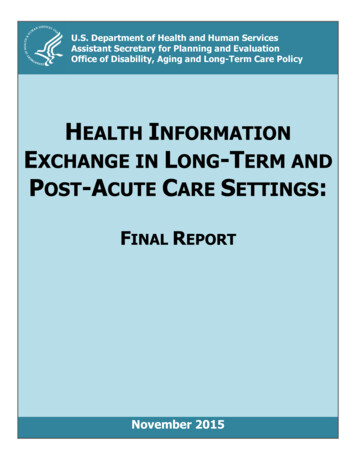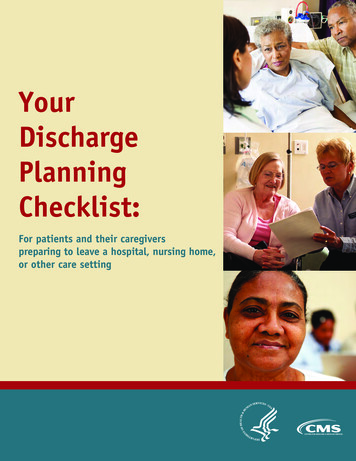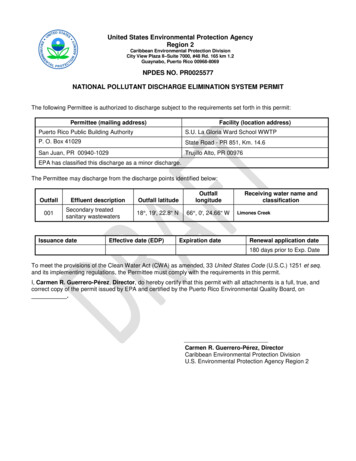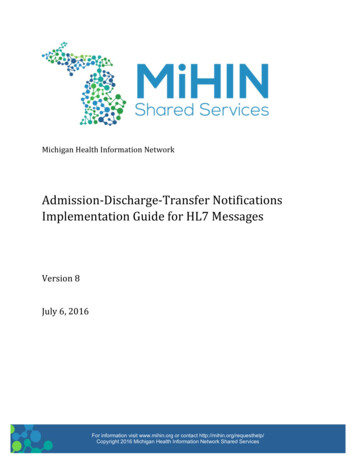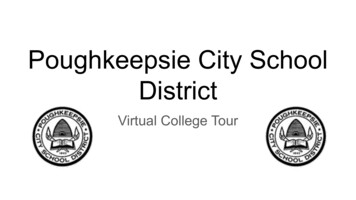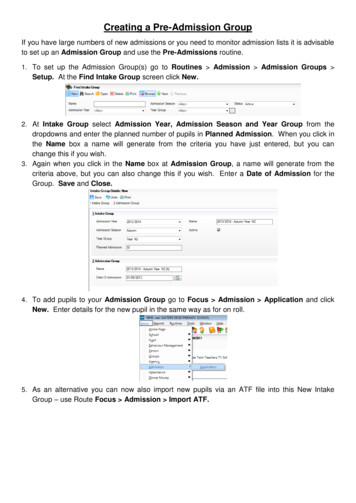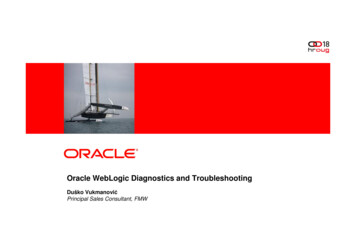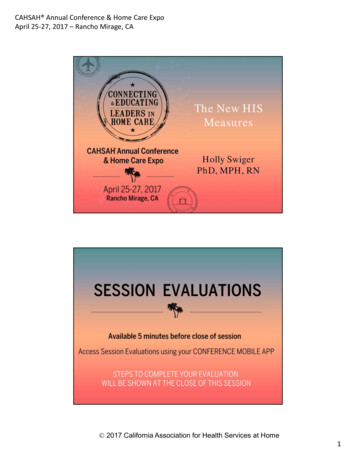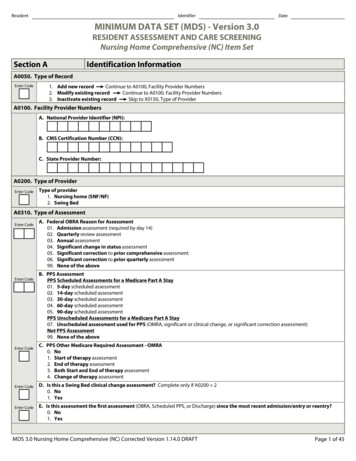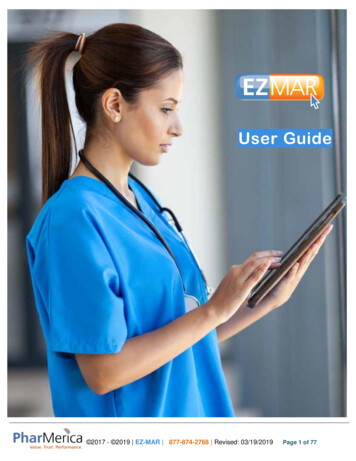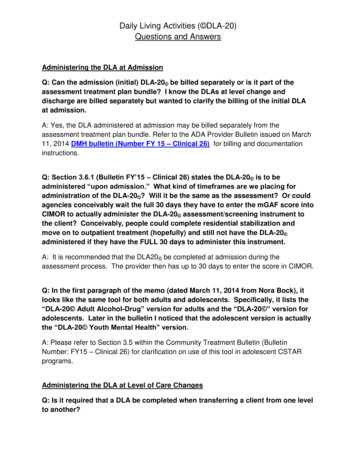
Transcription
Admission, Discharge, Transfer NotificationsImplementation GuideVersion 53July 28, 2020
Document 12121253Sections RevisedAllAllAll2DescriptionRevised into new templateProofed and made suggestedrevisionsFinal proof/editsEditsCopyright 2020 www.mihin.org http://mihin.org/requesthelp/ModifierS. SouthardA. JonesA. JonesK. Schramm
Table of ContentsAcronyms and Abbreviations Guide. 1Definitions . 21. Introduction . 71.1 Purpose of Use Case . 71.2 Message Content. 81.3 Data Flow and Actors . 82 Onboarding . 102.1 Prerequisites . 102.1.1 Universal Legal Prerequisites . 102.1.2 ADT Receiver Use Case Prerequisites . 102.2 Sending ADT Notifications . 102.2.1 ADT Sender Onboarding Process. 112.3 Receiving ADT Notifications. 122.3.1 ADT Receiver Onboarding Process . 122.3.2 MiHIN Standard Appended Z-Segments . 133 Specifications . 153.1 Sending Organization Requirements. 153.1.1 Segment Requirements for Sending Organization . 153.1.2 Segment Usage Requirements for Sending Organization . 153.1.3 Field and Subfield Requirements for Sending Organization. 163.1.4 Mapping Tables . 163.1.5 Conformance Reporting. 173.2 Receiving Organization Requirements . 183.2.1 Segment Requirements for Receiving Organization . 183.2.2 Segment Usage Requirements for Receiving Organization . 183.2.3 Field and Subfield Requirements for Receiving Organization . 193.2.4 Acknowledgment Message Requirements for Receiving Organization . 194 Troubleshooting . 204.1 Production Support . 205 Legal Advisory Language . 21Copyright 2019 www.mihin.org http://mihin.org/requesthelp/
Acronyms and Abbreviations GuideAPICCD CDA CEHRTCHAMPSCMSDQADSMEHREHR-MIPPEOBESIHL7 HDHIPPAISOMDHHSMIDIGATEApplicationProgramming InterfaceContinuity of CareDocument Clinical DocumentArchitecture Certified ElectronicHealth RecordTechnologyCommunity HealthAutomated MedicaidProcessing SystemCenters for Medicare &Medicaid ServicesData Quality AssuranceDirect SecureMessagingElectronic HealthRecordElectronic HealthRecord MedicaidIncentive PaymentProgramExplanation of BenefitElectronic ServiceInformationHealth Level Seven Health DirectoryHealth InsurancePortability andAccountability ActInternationalOrganization forStandardizationMichigan Departmentof Health and HumanServicesMedical InformationDirect GatewayMiHINNPIOIDPIPORASRESTSOMTDSOVPNXMLMichigan HealthInformation NetworkShared ServicesNational ProviderIdentifierOrganization ganizationRegistration andAttestation SystemRepresentational StateTransferState of MichiganTrusted Data SharingOrganizationVirtual Private NetworkExtended Mark-UpLanguageCopyright 2019 www.mihin.org http://mihin.org/requesthelp/1
DefinitionsActive Care Relationship (ACR). (a) For health providers, a patient who has been seen bya provider within the past 24 months, or is considered part of the health provider’sactive patient population they are responsible for managing, unless notice oftermination of that treatment relationship has been provided to Michigan HealthInformation Network Shared Services (MiHIN); (b) for payers, an eligible member of ahealth plan;(c) an active relationship between a patient and a health provider for thepurpose of treatment, payment and/or healthcare operations consistent with therequirements set forth in Health Insurance Portability and Accountability Act (HIPAA);(d) a relationship with a health provider asserted by a consumer and approved by thehealth provider; or (e) any person or Trusted Data Sharing Organization (TDSO)authorized to receive message content under an exhibit which specifies that an ACRmay be generated by sending or receiving message content under that exhibit. ACRrecords are stored by MiHIN in the Active Care Relationship Service (ACRS ).Active Care Relationship Service (ACRS ). The Michigan Health Information NetworkShared Services infrastructure service that contains records for those Trusted DataSharing Organizations, their participating organizational participants or any healthproviders who have an active care relationship with a patient.Admission, Discharge, Transfer (ADT). An event that occurs when a patient is admittedto, discharged from, or transferred from one care setting to another care setting or tothe patient’s home. For example, an ADT event occurs when a patient is dischargedfrom a hospital. An ADT event also occurs when a patient arrives in a care setting suchas a health clinic or hospital.ADT Message. A type of Health Level Seven (HL7 ) message generated by healthcaresystems based upon Admission, Discharge, Transfer (ADT) events and the HL7“Electronic Data Exchange in Healthcare” standard. The HL7 ADT message type is usedto send and receive patient demographic and healthcare encounter information,generated by source system(s). The ADT messages contain patient demographic, visit,insurance, and diagnosis information.ADT Notification. An electronic notification that a given patient has undergone anAdmission, Discharge, Transfer (ADT) event. An ADT Notification is not a complete ADTMessage.Applicable Laws and Standards. In addition to the definition set forth in the Data SharingAgreement, the federal Confidentiality of Alcohol and Drug Abuse Patient Recordsstatute, section 543 of the Public Health Service Act, 42 U.S.C. 290dd-2, and itsimplementing regulation, 42 CFR Part 2; the Michigan Mental Health Code, at MCLA §§333.1748 and 333.1748a; and the Michigan Public Health Code, at MCL § 333.5131,5114a.Caregiver. An individual such as a health professional or social worker who assists in theidentification, prevention or treatment of an illness or disability.Copyright 2020 www.mihin.org http://mihin.org/requesthelp/2
Care Package. The collection of documents sent to organizations that includeimplementation guides, connectivity documents, and other forms that requirecompletion to facilitate the onboarding process.Data Sharing Agreement. Any data sharing organization agreement signed by bothMichigan Health Information Network Shared Services (MiHIN) and a participatingorganization. Data sharing organization agreements include but are not limited to:Qualified Data Sharing Organization Agreement, Virtual Qualified Data SharingOrganization Agreement, Consumer Qualified Data Sharing Agreement, SponsoredShared Organization Agreement, State Sponsored Sharing Organization Agreement,Direct Data Sharing Organization Agreement, Simple Data Sharing OrganizationAgreement, or other data sharing organization agreements developed by MiHIN.Electronic Medical Record or Electronic Health Record (EMR/EHR). A digital version ofa patient's paper medical chart.Electronic Service Information (ESI). All information reasonably necessary to define anelectronic destination’s ability to receive and use a specific type of information (e.g.,discharge summary, patient summary, laboratory report, query forpatient/provider/healthcare data). ESI may include the type of information (e.g. patientsummary or query), the destination’s electronic address, the messaging frameworksupported (e.g. SMTP, HTTP/SOAP, XDR, REST, FHIR), security information supportedor required (e.g. digital certificate), and specific payload definitions (e.g., CCD C32 V2.5).In addition, ESI may include labels that help identify the type of recipient (e.g. medicalrecords department).End Point. An instance of an electronic address or Electronic Service Information.Exhibit. Collectively, a use case exhibit or a pilot activity exhibit.Health Directory. The statewide shared service established by Michigan HealthInformation Network Shared Services that contains contact information on healthproviders, electronic addresses, end points, and Electronic Service Information, as aresource for authorized users to obtain contact information and to securely exchangehealth information.Health Level Seven (HL7 ). An interface standard and specifications for clinical andadministrative healthcare data developed by the Health Level Seven (HL7) organizationand approved by the American National Standards Institute (ANSI). HL7 provides amethod for disparate systems to communicate clinical and administrative informationin a normalized format with acknowledgement of receipt.Health Information. Any information, including genetic information, whether oral orrecorded in any form or medium, that (a) is created or received by a health provider,public health authority, employer, life insurer, school or university, or healthcareclearinghouse; and (b) relates to the past, present, or future physical or mental healthor condition of an individual; the provision of healthcare to an individual; or the past,present, or future payment for the provision of healthcare to an individual.Copyright 2020 www.mihin.org http://mihin.org/requesthelp/3
Health Information Network (HIN). An organization or group of organizationsresponsible for coordinating the exchange of protected health information (PHI) in aregion, state, or nationally.Health Plan. An individual or group plan that provides or pays the cost of medical care (as“group health plan” and “medical care” are defined in section 2791(a)(2) of the PublicHealth Service Act, 42 U.S.C. 300gg-91(a)(2)). Health plan further includes thoseentities defined as a health plan under HIPAA, 45 C.F.R 160.103.Health Professional. Means (a) any individual licensed, registered, or certified underapplicable Federal or State laws or regulations to provide healthcare services; (b) anyperson holding a nonclinical position within or associated with an organization thatprovides or coordinates healthcare or healthcare related services; and (c) people whocontribute to the gathering, recording, processing, analysis or communication of healthinformation. Examples include, but are not limited to, physicians, physician assistants,nurse practitioners, nurses, medical assistants, home health professionals,administrative assistants, care managers, care coordinators, receptionists and clerks.Health Provider. Means facilities/hospitals, health professionals, health plans, caregivers,pharmacists/other qualified professionals, or any other person or organizationinvolved in providing healthcare.Health Insurance Portability and Accountability Act (HIPPA). United States legislationthat provides data privacy and security provisions for safeguarding medicalinformation.Information Source. Any organization that provides information that is added to aMichigan Health Information Network Shared Services infrastructure service.Master Use Case Agreement (MUCA). Legal document covering expected rules ofengagement across all use cases. Trusted Data Sharing Organizations (TDSOs) signmaster use case agreement one time, then sign use case exhibits for participation inspecific use cases.Message. A mechanism for exchanging message content between the participatingorganization to Michigan Health Information Network Shared Services, including queryand retrieve.Message Content. Information, as further defined in an Exhibit, which is sent, received,found or used by a participating organization to or from Michigan Health InformationNetwork Shared Services. Message content includes the message content header.Message Header (“MSH”) or Message Content Header. The Message Header (MSH)segment present in every Health Level Seven (HL7 ) message type that defines theMessage’s source, purpose, destination, and certain syntax specifics such as delimiters(separator characters) and character sets. It is always the first segment in the HL7message, with the only exception being HL7 batch messages.Copyright 2020 www.mihin.org http://mihin.org/requesthelp/4
Michigan Care Improvement Registry (MCIR). The Internet Information Service (IIS) forthe state of Michigan operated by the Michigan Department of Health and HumanServices (MDHHS).Michigan Health Information Network Shared Services (MiHIN). The healthinformation network for the state of Michigan.MiHIN Infrastructure Service. Certain services that are shared by numerous use cases.MiHIN infrastructure services include, but are not limited to, Active Care RelationshipService (ACRS ), Health Directory (HD), Statewide Consumer Directory (SCD), and theMedical Information Direct Gateway (MIDIGATE ).MiHIN Services. The Michigan Health Information Network Shared Services (MiHIN)infrastructure services and additional services and functionality provided by MiHINallowing participating organizations to send, receive, find, or use information to or fromMiHIN as further set forth in an exhibit.Notice. A message transmission that is not message content and may include anacknowledgement of receipt or error response, such as an Acknowledgement (ACK) orNegative Acknowledgement (NACK).Patient Data. Any data about a patient or a consumer that is electronically filed in aparticipating organization or participating organization participant’s systems orrepositories. The data may contain protected health information (PHI), personal creditinformation (PCI), and/or personally identifiable information (PII).Person Record. Any record in a Michigan Health Information Network Shared Servicesinfrastructure service that primarily relates to a person.Promoting Interoperability. Using certified electronic health record (EHR) technology toimprove quality, safety and efficiency of healthcare, and to reduce health disparities asfurther contemplated by Title XIII of the American Recovery and Reinvestment Act of2009.Provider Community. A healthcare provider with an active care relationship with theapplicable patient.Send/Receive/Find/Use (SRFU). Means sending, receiving, finding, or using messagecontent. Sending involves the transport of message content. Receiving involvesaccepting and possibly consuming or storing message content. Finding means queryingto locate message content. Using means any use of the message content other thansending, receiving and finding. Examples of use include consuming into workflow,reporting, storing, or analysis. SRFU activities must comply with Applicable Laws &Standards or State Administrative Code as that term is defined in this agreement andthe data sharing agreement.Source System. A computer system, such as an electronic health record system, at theparticipating organization, that sends, receives, finds or uses message content ornotices.Copyright 2020 www.mihin.org http://mihin.org/requesthelp/5
Statewide Consumer Directory (SCD). A Michigan Health Information Network SharedServices infrastructure service that helps organizations provide tools to consumers,which allow the consumers to manage how their protected health information (PHI)can be shared and used. The SCD is essentially a Software Development Kit (SDK) with arobust set of Application Programming Interfaces (API) that can be used by consumerfacing applications that enable consumers to take an active role in viewing and editingtheir preferences for how their health information is shared.Transactional Basis. The transmission of message content or a notice within a period oftime of receiving message content or notice from a sending or receiving party as may befurther set forth in a specific exhibit.Transitions of Care. The movement of a patient from one setting of care (e.g., hospital,ambulatory primary care practice, ambulatory specialty care practice, long-term care,rehabilitation facility) to another setting of care and can include transfers within ahealthcare organization.Trusted Data Sharing Organization (TDSO). An organization that has signed any form ofagreement with Michigan Health Information Network Shared Services for data sharing.Use Case. (a) A use case agreement previously executed by a participating organization; or(b) the use case summary, use case exhibit and a use case implementation guide thatparticipating organization or Trusted Data Sharing Organization must follow to sharespecific message content with the Michigan Health Information Network SharedServices.Use Case Exhibit. The legal agreement attached as an exhibit to the master use caseagreement that governs participation in any specific use case.Use Case Implementation Guide (UCIG). The document providing technical specificationsrelated to message content and transport of message content between a participatingorganization, Michigan Health Information Network Shared Services, and other TrustedData Sharing Organizations. UCIG are made available via URLs in exhibits.Use Case Summary. The document providing the executive summary, businessjustification and value proposition of a use case. Use case summaries are provided byMichigan Health Information Network Shared Services (MiHIN) upon request and viathe MiHIN website at https://mihin.org/use-case-categories/.View Download Transmit (VDT). A requirement for Promoting Interoperability with theobjective to provide patients with the ability to view online, download and transmittheir health information within a certain period of the information being available to aneligible professional.Copyright 2020 www.mihin.org http://mihin.org/requesthelp/6
1. Introduction1.1 Purpose of Use CaseSupports sending notifications on the status of a patients care transition(s) toevery care team member interested in that patient.Admission, discharge, transfer (ADT) notifications are widely regarded as a keystone forimproving patient care coordination through health information exchange. ADTnotifications are sent when a patient is admitted to a hospital, transferred to anotherfacility, or discharged from the hospital. Notifications are then sent to update physiciansand care management teams on a patient’s status, thus improving post-dischargetransitions, prompting follow-up, improving communication among providers, andsupporting patients with multiple or chronic conditions.ADT notifications also help to identify patients who are frequent or high users of thehealthcare system. This allows providers to steer those patients toward clinical and nonclinical interventions, reducing overutilization by preventing avoidable emergencydepartment visits and hospital readmissions.When a patient is admitted to a hospital, transferred, or discharged, an ADT notification iscreated by the hospital’s electronic health record (EHR) system. The hospital EHR systemsends the ADT notification through a Trusted Data Sharing Organization (TDSO) toMichigan Health Information Network Shared Services (MiHIN), which operates the ADTNotification service.Once received, MiHIN looks up the patient and the providers who are on the patients careteam using the Active Care Relationship Service (ACRS ). ACRS contains information onthe providers (e.g., attending, referring, consulting, admitting, primary care physician, etc.)interested in the patients’ health. MiHIN also looks up the providers in the Health Directoryto obtain the delivery preference for each of the providers and to determine the electronicendpoint and “transport” method by which the providers wish to receive ADT notifications(e.g., via Direct Secure Messaging, Health Level Seven (HL7 ) over Lower-Layer Protocol(LLP), etc.) for their patients.Based on the provider’s delivery preferences, MiHIN notifies each provider who has anactive care relationship with a patient upon the following ADT events: Patient is admitted to the hospital for inpatient or emergency treatment. Patient is discharged from the hospital. Patient is transferred from one care setting to another (e.g., to a different location [unit,bed] within the hospital or to another facility outside of the hospital). Patient’s demographic information is updated (e.g., name, insurance, next of kin, etc.) bya participating organization.Copyright 2020 www.mihin.org http://mihin.org/requesthelp/7
Note Related Use Case Requirements: Organizations entering this use case shouldsimultaneously enter into the Active Care Relationship Service (ACRS) and Health Directoryuse cases. These three use cases work together to support ADT Notifications.1.2 Message ContentFor this use case, Message Content refers to a message conforming to HL7 2.5.1 standardsidentified as an ADT message type and any message enrichments.1.3 Data Flow and Actors Actor: Sending Organization Role: Collects patient registration information and information about patientmovements within healthcare institutions. Forwards this information to MiHIN. Actor: MiHIN Role: Receives patient registration and movement information from SendingOrganizations. Forwards this information to Receiving Organizations. May addinformation to the message z-segment before forwarding. Actor: Receiving Organization Role: Receives patient registration and movement information forwarded by MiHINfrom Sending Organizations. Uses this information for treatment, payment andoperations.Figure 1. Organizations Tracking Patient Movement with ADT Notifications Use Case1. When Jorge goes to the hospital an ADT Notification is sent to MiHIN (sometimes via aTDSO).2. MiHIN checks the ACRS and identifies Jorge’s care team.3. MiHIN retrieves contact and delivery preferences for the care team from the HealthDirectory.4. The ADT Notification is sent to the care team based on their electronic addresses andpreferences.Copyright 2020 www.mihin.org http://mihin.org/requesthelp/8
SendingOrganizationReceive ADTEventSend orkReceiveADT EventAck Code AE:Invalid Syntax /SemanticsAck Code AA:Application AcceptAck Code AR: DBNot AvailableReceive ACKSend ACK with ACKCodeAddEnrichmentSend ADTEventReceiveADT EventAck Code AE:Invalid Syntax /SemanticsAck Code AA:Application AcceptAck Code AR: DBNot AvailableReceive ACKProcessMessageSend ACK with Ack CodeFigure 2. Data Flow for ADT Notifications Use CaseCopyright 2020 www.mihin.org http://mihin.org/requesthelp/9
2. OnboardingThe following guidelines describe the way in which an organization may onboard withMiHIN to send or receive ADT notifications. Additional documentation is available on theMiHIN use case page if needed ifications-use-case/). They include HL7 Vocabulary Terms and Static Definitions (bothshared with permission of HL7).2.1 PrerequisitesParticipating organizations should begin two parallel onboarding tracks simultaneously: Obtain, review, and execute legal agreements, and Establish technical transport and testing.2.1.1 Universal Legal PrerequisitesLegal agreements for organizations who are onboarding for the first-time consist of a DataSharing Organization Agreement, a Master Use Case Agreement, and Use Case Exhibits forany applicable use cases.Once an organization signs the Master Use Case Agreement, only a new Use Case Exhibit isrequired for each additional use case.To initiate the legal onboarding contact, email legal@mihin.org.2.1.2 ADT Receiver Use Case PrerequisitesReceiving ADT notifications requires participation in the following use cases: ADT Notifications ACRS Health DirectorySee Figure 1 (above) for an example of how these use cases work together.2.2 Sending ADT NotificationsThe Transitions of Care use case focuses on inpatient and emergency care settings such ashospitals, independent emergency care clinics, and skilled nursing facilities with patientstransitioning out of care and to an outpatient setting. The organizations providing inpatientand emergency care are classified as “ADT Senders”.Copyright 2020 www.mihin.org http://mihin.org/requesthelp/10
2.2.1 ADT Sender Onboarding ProcessFigure 3. ADT Sender Onboarding FlowchartFor ADT senders, onboarding steps include: Express interest in participating in the use case Kick-off meeting Exchange contact information Distribute ADT Notifications care package Execute legal documents Data Sharing Organization Agreement (if not already executed) Master Use Case Agreement (if not already executed) Use Case Exhibit Exchange required documents Transport document Completed mapping tables Establish transport method/connectivity (e.g., via health information exchange (HIE),virtual private network (VPN), or Direct Secure Messaging (DSM)) Provide sample ADT messages and test Complete validation process Go live Data Quality Assurance (DQA) period Enable feed for recipient(s)Copyright 2020 www.mihin.org http://mihin.org/requesthelp/11
2.3 Receiving ADT NotificationsThe Transitions of Care use case focuses on inpatient and emergency care settings withpatients transitioning out of care and into an outpatient setting such as a primary careprovider. The organization providing outpatient care is classified as “ADT Receivers”.2.3.1 ADT Receiver Onboarding ProcessFigure 4. MiHIN ADT Receiver Onboarding FlowchartFor ADT Receivers, onboarding steps are as follows: Express interest in participating in the use case Kick-off meeting Exchange contact information Distribute ADT Notifications care package Execute legal documents Data Sharing Organization Agreement (if not already executed) Master Use Case Agreement (if not already executed) Use Case Exhibit Exchange required documents Transport document Send ACRS file(s) securely Validate ACRS file(s)Copyright 2020 www.mihin.org http://mihin.org/requesthelp/12
Establish transport method/connectivity (e.g., via HIE, VPN, or DSM) Go live2.3.2 MiHIN Standard Appended Z-SegmentsMiHIN can enrich messages by adding content to the Z-segment of an ADT message. Thefollowing message enrichments are standard and will be added to the Z-segment ofmessages if they are available. For more information on the Z-segments listed below,contact MiHIN’s onboarding department at onboarding@mihin.org.2.3.2.1 NPI Z-SegmentFor every provider match in the ACRS against an ADT notification, the correspondingprovider National Provider Identifier (NPI) will be appended to the receiver’s ADTnotification.Format: ZNP ACRSNPI 12345678902.3.2.2 Common Key Z-SegmentIf an ADT is identified as a patient with a common key, then the patient’s common key willbe appended to the receiver’s ADT notification.Format: ZCK CKS 91823981282.3.2.3 Member ID Z-SegmentWhen a patient is matched with a receiver’s ACRS file, the common key from the file will beappended to the receiver’s ADT notification.Format: ZPD PATIENTID 123456782.3.2.4 Risk Score Z-SegmentMessage enrichment which provides one or more risk scores for the patient. If more thanone score is available, a corresponding number of ZPR segments will be appended to themessage.Format: ZPR SET ID SCORE TYPE SCORE CATEGORY SCORE VALUE SCOREDATE SCORE DESCRIPTION SCORE OID SCORE EXPIRATION DATE2.3.2.5 Explanation of Benefits (EOB) Z-SegmentWhen a patient has Explanation of Benefits (EOB) information available and accessible tomembers of their active care team, an organization identifier (OID) for each EOB issuer(health insurance or
An ADT event also occurs when a patient arrives in a care setting such as a health clinic or hospital. ADT Message. A type of Health Level Seven (HL7 ) message generated by healthcare systems based upon Admission, Discharge, Transfer (ADT) events and the HL7 "Electronic Data Exchange in Healthcare" standard. The HL7 ADT message type is .
